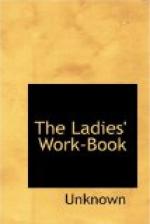FOUNDATION STITCH (No. 23). This is ordinary button-hole stitch, worked over a thread, and as closely as possible. The thread is taken across the space, from right to left, to form a bar, which is then covered with close Brussels, worked from left to right. Each stitch of a row is worked between two of the previous rows.
ESCALIER STITCH (No. 24). Work nine button hole stitches as close to each other as possible. Miss the space of two, and repeat. In the second row, work one after each of the first seven, miss the space of the last two, work two on the loop, and seven more on the next nine, miss the last two of the nine; repeat in every successive row, passing over the last two of nine stitches, and doing two on the vacant space.
CADIZ LACE (No. 25). Do six close Brussels stitches. Miss the space of two, do two more, and again miss the space of two, repeat from the six stitches.
2nd row: Do two over the loop of every space, and miss all the stitches, whether six or two. Repeat these two rows alternately, to form the lace.
BARCELONA LACE (No. 26). The first row of this lace is exactly like Sorrento edging.
2nd row: Do four close stitches on the long stitch, and miss the short one, taking care not to draw the thread too tightly.
3rd: A row of Sorento edging, the long stitch coming over the four stitches of the last row, and both the button-holes being worked on the loop, so that the short stitches come over the short of the first row. These two rows, worked alternately, make the lace.
FAN LACE (No. 27), 1st row: Six close Brussels, miss the space of six. Repeat.
2nd: Six stitches over every six, miss the same space.
3rd: Six close Brussels on every loop, missing the space between.
4th: Six over every six, and six on every loop.
5th: Six close over the six on the long loop, miss the other six. Repeat these last three rows as often as may be required to fill up the space.
[Illustration: LITTLE VENETIAN LACE.]
SPOTTED LACE (No. 28). This very light and pretty lace is done thus:—
1st: X two close button-hole stitches, miss the space of four, X repeat to the end, without drawing the thread too tightly.
Begin the next row, and all following, at a little distance from the one preceding, and do two close stitches on every loop of thread.
VENETIAN SPOTTED LACE (No. 29). This lace consists of a series diamonds, formed by Venetian bars crossing each other diagonally, in each of the sections of which, four spots of English lace are to be worked. The foundation threads of the Venetian bars are first laid; then the English lace spots are worked, and the button-hole stitch of the Venetian bars is done the last. This lace is well suited to fill up large spaces.
OPEN ANTWERP LACE (No. 30). For this lace a new stitch is required, called the double Brussels. Instead of a simple button-hole stitch, the needle is twisted once in the loop, so that when drawn up, it has a longer appearance than the ordinary Brussels. The stitches are to be worked quite close to each other.




